In a fierce battle between two bitter rivals in La Liga, Sevilla welcomed Barcelona to Andalusia as the two giants squared off at the Ramón Sánchez Pizjuán Stadium. In a perhaps surprising turn of events, Ronald Koeman’s troops edged out their opposition in a 2-0 victory on the day.
But what was even more impressive is how they’ve done it, completely outplaying Sevilla to claim the three points. This tactical analysis will aim to reveal both teams’ tactics and tell you how Barcelona won the match.
Lineups
Julen Lopetegui opted for a 4-2-3-1 structure on the day as Yassine Bounou was protected by a quartet that consisted of Sergio Escudero, Diego Carlos, Jules Koundé and Jesús Navas. In midfield, the home side deployed Fernando and Joan Jordán down the middle channels while Ivan Rakitić joined Munir and Papu Gómez just behind Luuk de Jong.
This structure and lineup ended up being quite lacking against Barcelona’s tactics so Lopetegui had to made some big changes at one point in the second half.
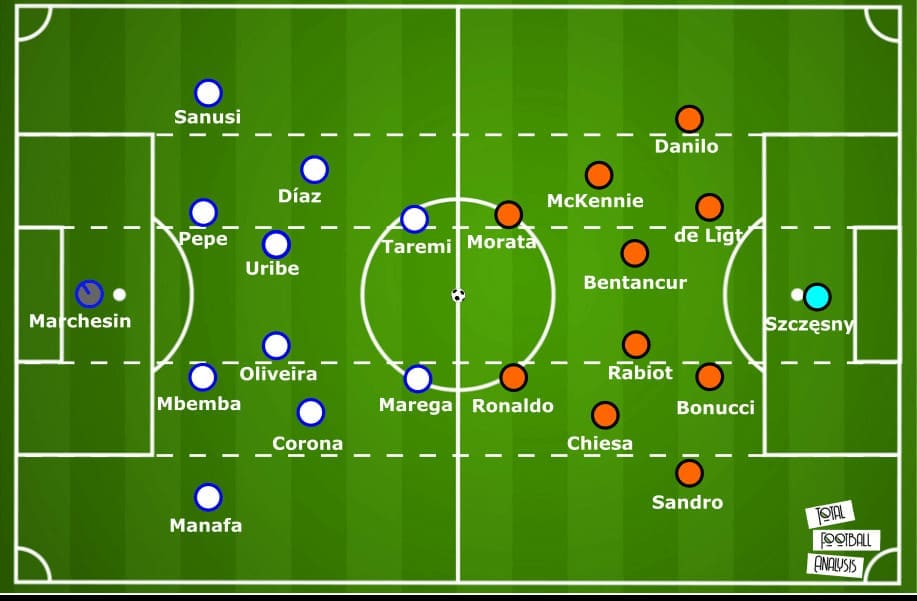
Koeman, on the other hand, decided to innovate. Instead of the traditional 4-3-3, we saw this new-look Barcelona in a 3-5-2 formation in possession and a variation between 4-4-2 and 5-3-2 in the defensive phase. Jordi Alba and Sergiño Dest acted as wing-backs while Ousmane Dembélé was given a more central role with less defensive responsibility.
With the introduction of the three-in-the-back, Barcelona were able to get the best out some of their key players, which will be further dissected in this tactical analysis.
Barcelona’s new pressing mechanisms
For a long time now, Barcelona’s defensive performances have been sub-par and their pressing, in particular, left a lot to be desired. This was a huge problem because they relied on that aggressive approach to suffocate the opposition and recover possession high up the pitch. But with a largely disconnected structure, both on and off the ball, it was often easy for their opponents to play through them and exploit their weaknesses.
However, against Sevilla, we saw a much different approach altogether as Barcelona swapped between their usual 4-4-2 structure and the newly-introduced 5-3-2. Since both Alba and Dest were initially higher up the pitch, they would subsequently tuck in and track Sevilla’s wide men who wanted to run in-behind the defensive line.
But those same wingbacks would push higher when Barcelona tried to press. In such scenarios, we saw a very man-marking heavy approaching from the Catalans that aimed to shut down passing channels and mark Sevilla’s main progressors out of the game.
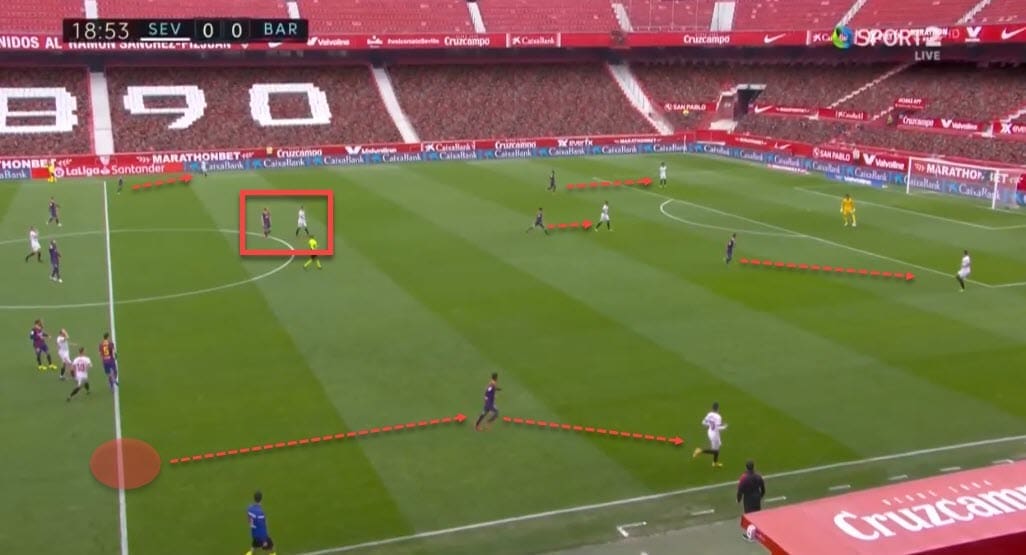
You can see a good example of that shift in pressing structure and the man-marking approach above. We see the initial five-in-the-back shape with both Alba and Dest deeper but when it’s time to press, they both push up and apply pressure on their counterparts.
Apart from that, notice how Barcelona keep Sevilla’s vents tightly marked and tracked. One of the issues for the Andalusians is that they couldn’t make use of the +1 advantage when using Bounou on the ball. But a big part of that was the Catalans’ success in depleting them of any real options in possession.
Still, there were chances for them to progress past Barcelona’s pressing system at times when good movement was combined with Bounou’s on the ball abilities. However, these chances weren’t exactly taken and instead of taking a risk and making good split-second decisions, Sevilla’s intuition was to take it far too slow.
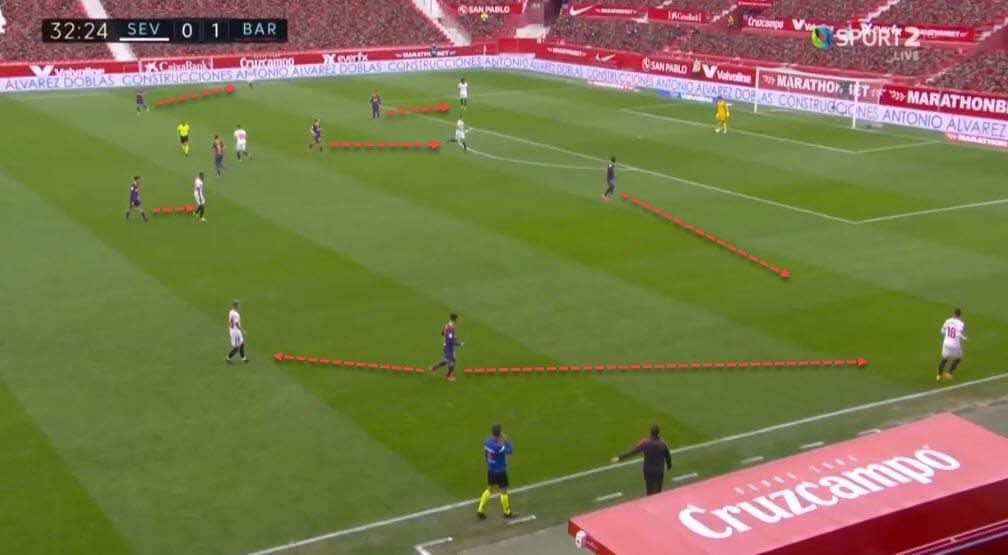
For instance, notice in the example above how Sevilla have successfully created an overload on Dest by dropping Papu Gómez deeper. This also forces Barcelona to break their defensive structure and move more players from their backline higher up. By doing that, of course, space would appear in other areas that could be exploited.
But Sevilla couldn’t make use of it because they didn’t have any outlets other than a long ball towards De Jong, which we’ll touch upon further down the line of this tactical analysis. Again, though, a lot of that had to do with Barcelona’s own approach.
Let’s look at another example of their effective pressing down below. It seemed like Barcelona were willingly letting the wide players open for Bounou to pick up from his box. Whether it was Koundé drifting wide to receive like in the following image or the likes of Navas finding themselves free, often it felt intentional rather than like weakness in Barcelona’s tactics.
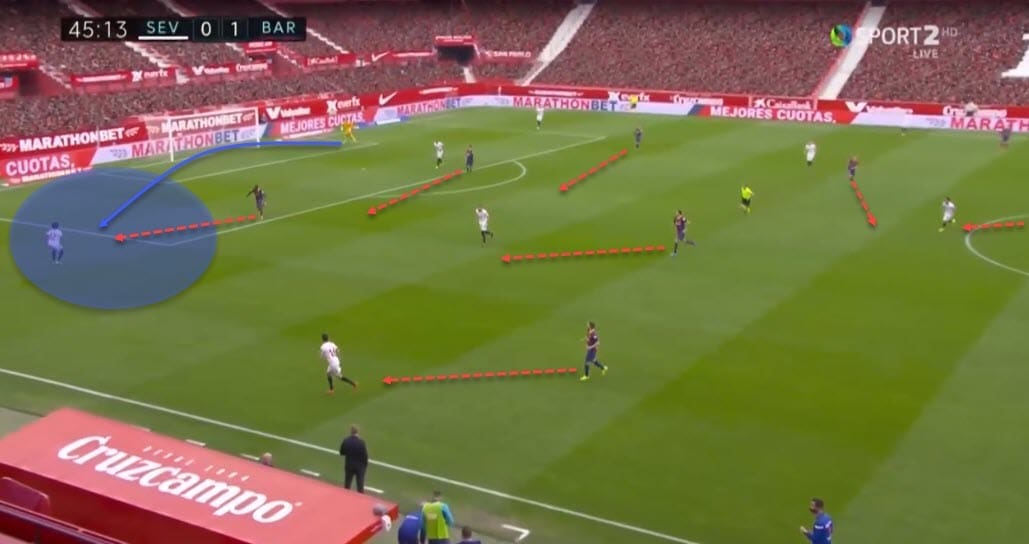
Notice how Barcelona allow Sevilla to shuffle possession out wide and then proceed to collapse on them as soon as Koundé receives the ball. The sequence doesn’t end immediately but despite successfully playing a couple of quick passes, the hosts lose the ball in a danger area which leads to a Barcelona transition.
The Catalans made 18 recoveries and seven interceptions in the opposition’s half, successfully pressing Sevilla into submission and forcing them to resort to long balls and switches of play to advance up the pitch. As a result, the hosts deployed a total of 46 long passes on the day with the link between Bounou and De Jong being the strongest with six passes in total from the goalie to the striker.
Even for a side that is not afraid to go long, especially when it comes to diagonal balls into space, this was pretty telling of their issues in progression.
Dembélé’s new role
Even though Barcelona’s defensive tactics were a big part of their victory, it was how well they managed to play to their forwards’ strengths that ultimately won them the game. In attack, the Catalans were deployed in a 3-5-2 formation as Dest and Alba had joined the midfield trident to completely overload Sevilla’s midfielders.
In their last clash before this game, it was Sevilla’s midfield that had dominated the match, bullying Barcelona and winning them the game. To tackle this issue, Koeman created superiorities in this part of the pitch and moved Dembélé into a central role. By doing that and putting a back three behind Sergio Busquets who was the pivot, he created a more stable possession phase that also ensured a far safer defensive transition.
But it was also crucial Dembélé was given the ideal circumstances to wreak havoc. Sevilla were mostly defending in a 4-2-3-1 defensive structure and would man-mark the French winger at all times. However, with Barcelona repeatedly occupying their backline, they managed to isolate Dembélé in 1v1 scenarios numerous times throughout the game.
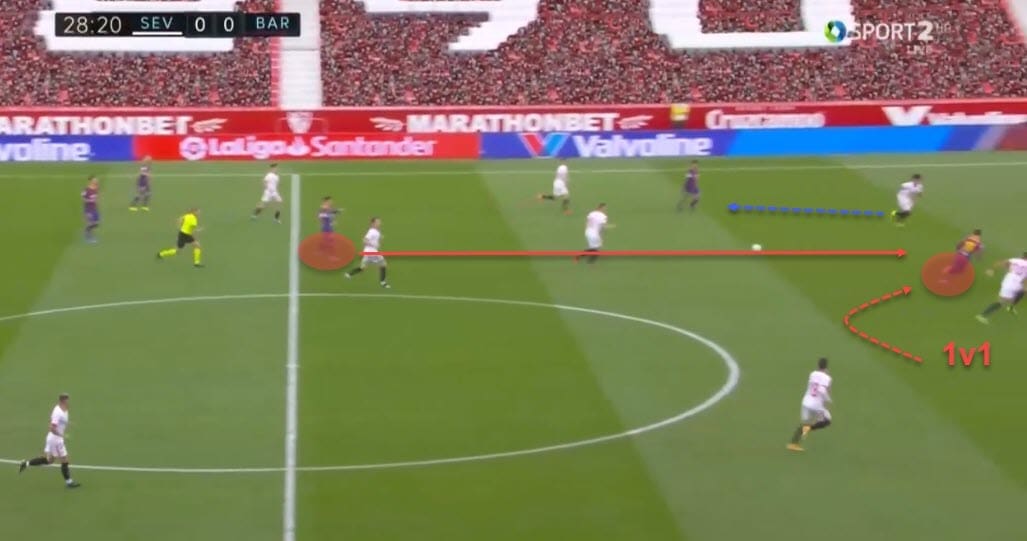
Let’s analyse the first goal the Catalans scored. Lionel Messi receives the ball in space after Fernando abandoned his position beforehand. However, it’s the positioning of Pedri that occupies Koundé and ensures Dembélé is in a 1v1 battle with Carlos.
The winger makes a curved run from a central position and leaves Sevilla’s centre-back in his dust shortly after. Seconds later, the Andalusians have to retrieve the ball from their net and restart from the centre. Barcelona knew that if Dembélé made the run into space and was in a foot-race, even if outnumbered, he could still win that duel.
Their second goal was the result of an excellent sequence in the final third but they had a couple of other excellent chances to score that came through the very same principle we just discussed.
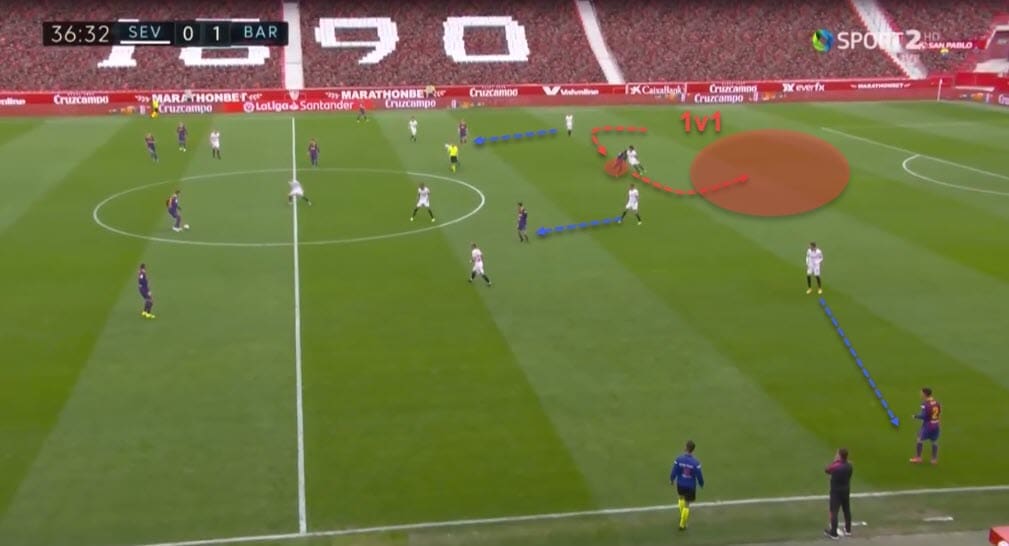
Let’s take the image above as our next example of this central role and using curved runs. It’s important to note that Barcelona didn’t make use of that movement in this instance but it does perfectly depict how they could’ve.
De Jong and Pedri are positioned between the lines, keeping one centre-back and one full-back occupied and in a decisional crisis while Dest ensures the backline is also stretched. This leaves Dembélé in a 1v1 situation once again.
Of course, as we mentioned earlier, Barcelona opted for the short option here but the chance was there for the taking. In the second half, Messi also had an opportunity to finish from close range, which he failed to do, but it was an opportunity created by this very same principle.
Pedri is once again between the lines and his movement attracts Koundé who steps up and follows his man. This, however, drags him out of position and puts Dembélé in another 1v1 against Carlos.
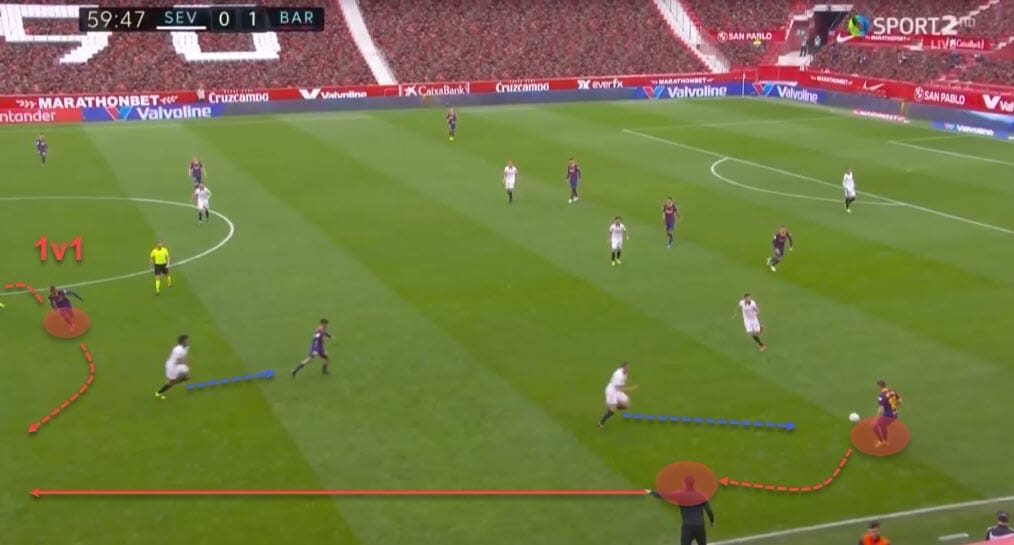
It has to be noted that the individual brilliance of the Frenchman played a huge role in this attempt as in theory, with the player receiving the ball with back to goal, there’s little chance of progression. However, Dembélé dribbles past Carlos without even touching the ball initially and is then in a foot race against Koundé who has a lot of ground to make up for.
A timely cut-back puts Messi in an ideal position to score but luckily for Sevilla, the Argentine fails to convert the chance. Still, it were once again the same attacking tactics that led to a dangerous opportunity.
Too little, too late for Sevilla
For the majority of the first 45 minutes, Sevilla were struggling to get out of their half. We’ve already discussed earlier in this tactical analysis how that was due to Barcelona’s successful and intense pressing which cut off all of Andalusians’ main progressive valves.
The backline was heavily pressurised, the midfield man-marked and the channels to dropping forward like Gómez closed shut. As a result, long balls into De Jong were all Sevilla could do in the first half.
Often it was either a ball from the backline or the goalie himself that would ideally find the Dutchman, who in turn, had to win the aerial duel and deploy a lay-off for his teammates.
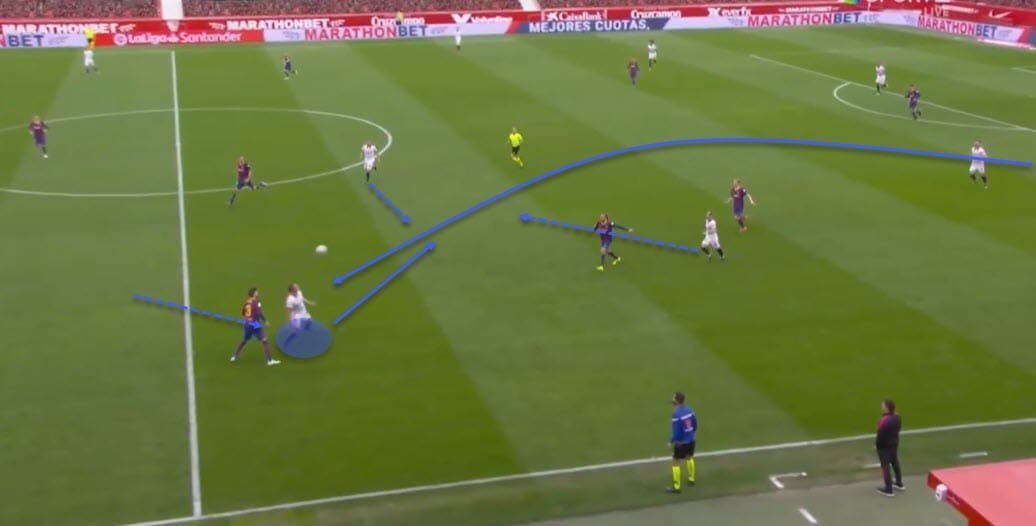
However, the back three of Barcelona effectively dealt with De Jong, often doubling down on the striker, while the wide and dropping options were matched at least man-to-man. This led to Lopetegui changing his approach in the second half as he introduced the likes of Suso, Youssef En-Nesyri and Óliver Torres who offered runs, better link-up & movement and press-resistance respectively.
In essence, Sevilla’s approach didn’t change that much but the new personnel was much better utilised. They were still aiming for long diagonal switches from left to right that would make use of wide overloads on Barcelona’s full-backs.
For instance, take a look at the example below as Suso and Navas overload Alba and Sevilla use their swapping tactics to find their men in space.
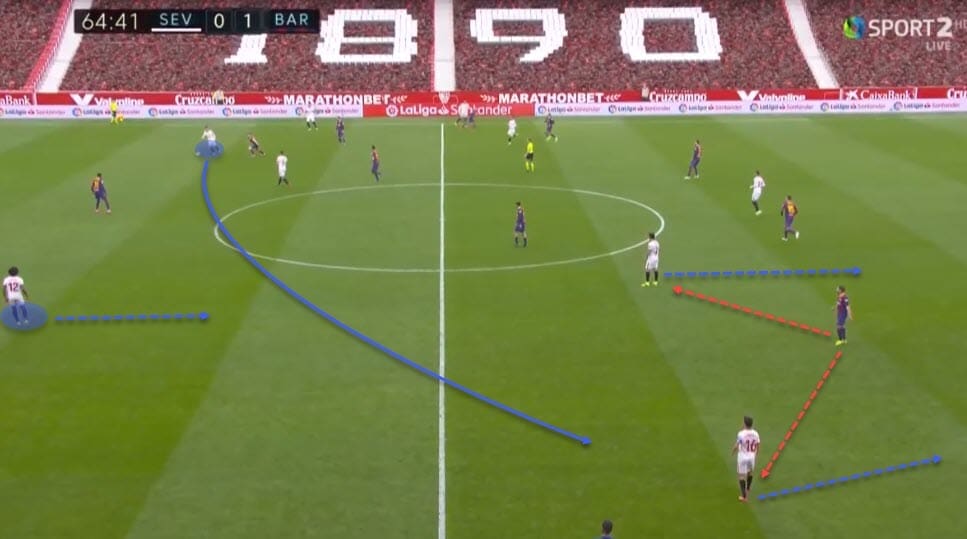
It should be pointed out that there was the possibility to play the ball to Koundé who was free to run with it into the open channel and that way attract Pedri to step up. In this particular instance, the switch is aimed at Suso and Sevilla’s forward fails to get to the ball but the intention and the tactics were clear.
Let’s explore a couple of situations where that was more successful though. The obvious scenario was in a transition period where Suso could carry the ball into the final third and advance through the half-space while Navas overlapped to his right.
That would put Alba in a situation where he simply can’t cover them both, as can be seen below. But it’s also important to note how Sevilla pin other Barcelona defenders and stretch the backline so that Alba is left without adequate support.
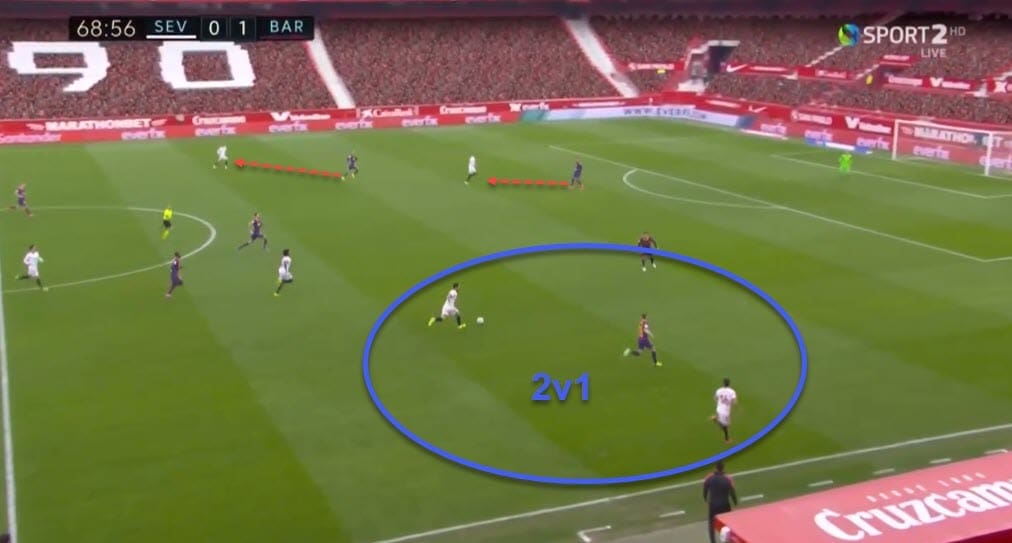
Finally, we’ll go over one situation in which this overload was used in a more settled possession-phase situation. Sevilla are in Barcelona’s half and the ball is once again being progressed down their right side.
You can see three main areas they could potentially unlock by manipulating and overloading Barcelona’s backline. Suso in the right half-space and Navas on the overlap ensures a 2v1 against Alba and since the full-back cannot commit to either, the ball-carrier is free to run with the ball.
That also means players from other lines have to collapse quickly as both centre-backs are also occupied at the same time.
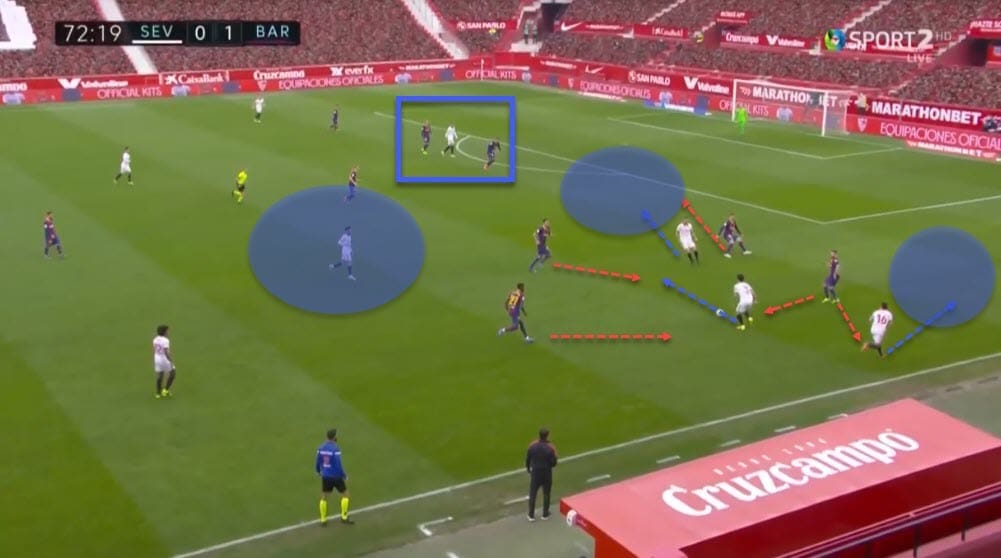
It’s a good example of how one overload can open so many doors for the attacking team. Unfortunately for Sevilla, they failed to make use of it but their attacks did look far better in the latter parts of the second half.
Conclusion
This was Koeman’s first convincing and dominating win over a direct rival in the table this season. While one triumph doesn’t magically mean all of their issues are gone, it’s still a good sign for the remainder of the season as they continue their chase of Atletico Madrid.
Sevilla, on the other hand, have been stumbling in their last couple of games. Nothing is lost just yet, though, as Lopetegui has a squad that should and will be fighting for a lot this season.






Comments